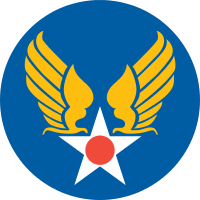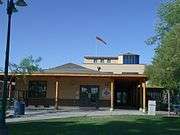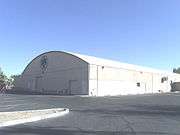Thunderbird Field No. 1
Thunderbird Field No. 1 | |
|---|---|
| Part of Arizona World War II Army Airfields | |
| Glendale, Arizona | |
|
Aerial photograph of Thunderbird Field taken 2006 | |
 Thunderbird Field No. 1 | |
| Coordinates | 33°37′21.78″N 112°11′6.82″W / 33.6227167°N 112.1852278°W |
| Type | USAAF Contract Flight Training School |
| Site information | |
| Controlled by | Army Air Forces Training Command |
| Site history | |
| Built | 1939 |
| In use | 1941-1944 |
Thunderbird Field was a military airfield in Glendale, Arizona, used for contract primary flight training of Allied pilots during World War II. Created in part by actor James Stewart,[1] the field became part of the United States Army Air Forces training establishment just prior to American entry into the war and was re-designated Thunderbird Field #1 after establishment of Thunderbird Field #2 at nearby Scottsdale, on 22 June 1942. Thunderbird # 1 is located southeast of the intersection of West Greenway Road & North 59th Avenue in Glendale, Arizona.
After the conclusion on World War II, the property was sold as surplus for educational purposes, eventually becoming the Thunderbird School of Global Management, a post-graduate business school.
History
Thunderbird Field began in 1939 as a collaborative project by Hollywood agent and producer Leland Hayward, former Air Service pilot John H. "Jack" Connelly, and Life magazine photographer John Swope, founders of Southwest Airways. Backed by investors that included James Stewart, singer-actor Hoagy Carmichael, Cary Grant, Henry Fonda, Robert Taylor, and Margaret Sullavan, construction of the pilot training facility near Glendale, Arizona,[2] began on 2 January 1941, and was completed in three months.
The site, 25 miles (40 km) from central Phoenix, was laid out by artist Millard Sheets to resemble (from the air) an etching of a mythical Anasazi Thunderbird. The control tower formed the head of the bird, the administration buildings and barracks its body, the hangars its wings, and the gardens its feathered tail. The installation was situated on the southeast corner of what is now West Greenway Road & North 59th Avenue. To the southeast, adjacent to its single-story sage, cream, and terra cotta-colored buildings of Spanish Colonial rancheria design, was a square 2,800-square-foot (260 m2) ramp area. Across West Greenway Road to the north was the airfield itself with three 3,500-foot (1,100 m) runways.
Contractor Del Webb Construction built a hexagonal barracks, administrative building, mess hall and four hangars on the site, plus twin swimming pools. The US Army Air Forces signed a contract with Southwest Airways to provide instructors and facilities for a primary training school for its aviation cadets in March 1941, beginning with a class of 59 candidates. Eventually 10,000 pilots from 30 nations trained at the field before it was deactivated in June 1945.[3] A 1942 Hollywood movie in Technicolor, Thunder Birds (directed by William Wellman), was filmed on location at the field in the spring of 1942. Aerial shots clearly show the original Thunderbird design.
Four unpaved satellite airfields were operated by Thunderbird Field between 1942 and 1944:
- Thunderbird #1 Auxiliary Airfield A-1 (33.64N 112.10W), northeast of West Bell Road and North 19th Avenue;
- Thunderbird #1 Auxiliary Airfield A-2 (33.65N 112.24W), in Sun City northwest of West Union Hills Road and North 83rd Avenue;
- Thunderbird #1 Auxiliary Airfield A-3 (33.58N 112.10W), at West Peoria Avenue and North 19th Avenue;
- Thunderbird #1 Auxiliary Airfield A-4, at West Pinnacle Peak Road and North 43rd Avenue.
Southwest Airways expanded the training complex with the building of two other airfields, Falcon Field at Mesa in September 1941, and Thunderbird Field #2 in Scottsdale in June 1942.
After World War II
Following the end of World War II, Thunderbird Field was declared surplus by the War Assets Administration in 1946. That same year, Thunderbird was purchased for $1 from the federal government by Lt. General Barton K. Yount, retired commander of the Army Air Forces Training Command. He established the American Institute for Foreign Trade and became its first president.
Classes began on the site within a few months, however the airfield at Thunderbird may have continued in operation alongside the new school for some time. Thunderbird Field was apparently closed (permanently) at some point within the next year.
Thunderbird Field inspired the name of Thunderbirds, a British mid-1960s television show that used marionettes. The eldest brother of Gerry Anderson, the creator of the show had been stationed at the base and wrote about his experience there.[4]
Historical structures
Today, the former airfield is still the location of the school, known currently as Thunderbird School of Global Management. The campus still contains many original airfield buildings, including the airfield control tower (which has been restored), barracks, and one large airplane hangar.
| Thunderbird_1_Army_Air_Field historic structures | ||||||||||
|---|---|---|---|---|---|---|---|---|---|---|
|
See also
- Arizona World War II Army Airfields
- 37th Flying Training Wing (World War II)
- Thunder Birds (1942 film)
- List of historic properties in Glendale, Arizona
- Glendale, Arizona
References
![]() This article incorporates public domain material from the Air Force Historical Research Agency website http://www.afhra.af.mil/.
This article incorporates public domain material from the Air Force Historical Research Agency website http://www.afhra.af.mil/.
| Wikimedia Commons has media related to Thunderbird Field No. 1. |
- Shaw, Frederick J. (2004), Locating Air Force Base Sites History’s Legacy, Air Force History and Museums Program, United States Air Force, Washington DC, 2004.
- Manning, Thomas A. (2005), History of Air Education and Training Command, 1942–2002. Office of History and Research, Headquarters, AETC, Randolph AFB, Texas ASIN: B000NYX3PC
- Nalty, Bernard C. (1997). "Reaction to the War in Europe", Winged Shield, Winged Sword:A History of the United States Air Force, Air University Press, USAF Washington, D.C. ISBN 0-16-049009-X, pp. 177–178.
- Orson Falk, "Thunder Birds", Random House (1942).
- ↑ From The Soldier's Book of Inspirational Stories, by R.Dale Jeffery, 1997.
- ↑ From "The History of Thunderbird," Parts 1 and 2, in Das Tor, October 1992.
- ↑ Hyer, Charles F. (Fall 1985). "Falcon Field Beginnings". American Aviation Historical Society Journal. 30 (3): 175.
- ↑ Gerry Anderson - The Authorised Biography, by Simon Archer & Stan Nicholls, 1996, pp85-86, ISBN 0-09-978141-7.
External links
- Arizona Memory Project - period photographs - including photos of key founders Connelly, Hayward and Swope
- Thunderbird Field - period photographs






